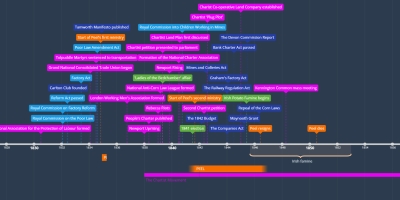The Chartist Movement (1 янв 1838 г. – 31 дек 1857 г.)
Описание:
The Chartists were a popular working class movement who were way ahead of their time. Their aims were difficult to achieve at the time.Relatively popular movement
- crowd of 159,000 at the meeting which launched the People's Charter
- Chartist newspaper had over 40,000 readers in 1839
- large-scale protests
- The National Charter Association was more moderate and less radical, rejecting violence and had 50,000 paid-up members within two years of its foundation
- parliament claimed a petition signed by 5 million in 1848 only had 2 million valid signatures sparked a peaceful mass process that the authorities were concerned would lead to a revolution.
Chartism attracted victims of economic change who saw the movement as a protest against hard times (e.g. factory workers - being replaced by machines, domestic workers - suffered competition from factories, the poor, Irish immigrants). It was initially London based but spread out widely. They did well in establishing aims, gaining support, setting up local organisations, publicising their ideas and preparing Britain for changes. Politicised the working class, giving them the experience of organising themselves and provided a means of expressing concerns about economic change and modernisation. When there were economic improvements (decreasing unemployment, lower prices, better conditions, better wages) support declined - support of the Chartist movement therefore fluctuated.
methods:
- petitions
- large-scale meetings
- strikes and violence (caused by rejection of petitions)
- formation of the National Charter Association in July 1840 which rejected violence and focused on getting working class MPs and local councillors elected
The Chartist movement was split - some were more radical and others were more peaceful. They had mostly different objectives and were not a united front and there was no union of rural and urban discontent. The leaders were also diverse e.g. some businessmen, some from rural background and so often disagreed. Some believed in armed revolution and some believed in 'moral force'.
Support decreased in times of economic upturn when unemployment decreased and prices were lowered. Furthermore, the government wasn't prepared to make concessions on further reform and used force when it thought necessary. The government also recruited special constables and used spies and informers so they knew the plans of the Chartists. The government also used the railways to quickly transport troops.
Добавлено на ленту времени:
Дата:
1 янв 1838 г.
31 дек 1857 г.
~ 20 years
